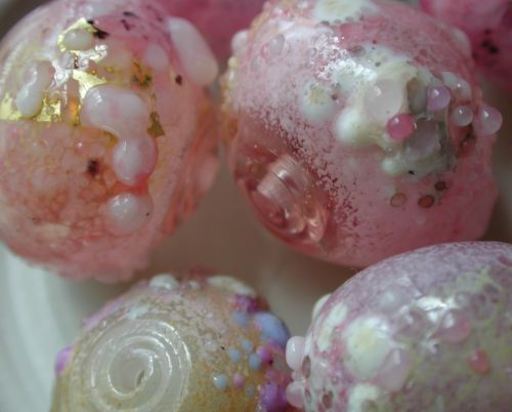I had a show coming up; I had all these chunks of frit; I had just sold a lot of beads to Bead Monkey (wonderful store in Minneapolis—check ’em out); I needed some beads for it. The buyer had commented that the beads she selected “were nice light colors, good for spring.”

I'm terrible at following trends; even when I did 9/11 beads, I was the only person (I know of, anyway) to do them on black. (Well, shouldn't there be an element of mourning?) Anyway, it would be just like me to do reds and oranges in spring, and pastels in the autumn, because I tend to go where my fancy takes me. But just this once, I figured, hey, why not? Spring colors. And I could try working on alabastros, which I hadn't done in a long time.

For those of you who are not glass beadmakers, the most popular glass is the soft soda lime “effetre”, commonly still called Morretti (factory got sold) and single color rod comes in 5 classes: transparents; pastels and specials (which roughly speaking are the cool and warm colored opaques, respectively), and alabastro and opalinos, which are translucent and indistinguishable from each other, at least with the naked eye. Alabastros and opalinos have the reputation for being harder to work, and somewhat incompatible. I certainly had fits with the ivory base glass I used to make these beads spitting and breaking all over the place, but I'm hoping I simply got a bad batch. These colors do boil more easily, and they're less viscous (more goopy) than most of the standard effetre colors. (Just as an aside, transparents are generally the stiffest, colorless excepted, and ivory is the goopiest of the opaques, by quite a bit.)
Unless otherwise noted, text, image and objects depicted therein copyright 1996--present sylvus tarn.
Sylvus Tarn